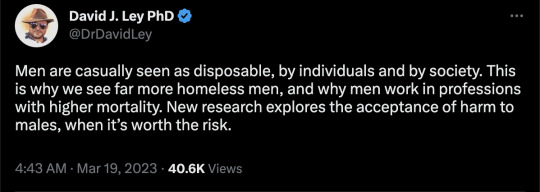#women and children first
Text

The sinking of HMS Birkenhead, by Charles Edward Dixon (1872-1934) Based on this event - HM Steamer Birkenhead
85 notes
·
View notes
Text
What if it went like this


#women and children first#goodbye loid#spy x family#spy x family ch44#sxf#sxf manga#spy x family manga#anya forger#loid forger#yor forger#yor briar#cuise adventure arc
84 notes
·
View notes
Photo

4:45 AM EDT October 30, 2023:
Van Halen - "Could This Be Magic?"
From the album Women and Children First
(March 26, 1980)
Last song scrobbled from iTunes at Last.fm
★★★★
File under: Question Songs
31 notes
·
View notes
Text

I missed Women & Children First. Thank you to all businesses who continue to require masks.
#women and children first#the mountain in the sea#the pandemic isn’t over#bookworm#independent bookstore#indie bookstore
43 notes
·
View notes
Text


Abstract
Scientific and organizational interventions often involve trade-offs whereby they benefit some but entail costs to others (i.e., instrumental harm; IH). We hypothesized that the gender of the persons incurring those costs would influence intervention endorsement, such that people would more readily support interventions inflicting IH onto men than onto women. We also hypothesized that women would exhibit greater asymmetries in their acceptance of IH to men versus women. Three experimental studies (two pre-registered) tested these hypotheses. Studies 1 and 2 granted support for these predictions using a variety of interventions and contexts. Study 3 tested a possible boundary condition of these asymmetries using contexts in which women have traditionally been expected to sacrifice more than men: caring for infants, children, the elderly, and the ill. Even in these traditionally female contexts, participants still more readily accepted IH to men than women. Findings indicate people (especially women) are less willing to accept instrumental harm befalling women (vs. men). We discuss the theoretical and practical implications and limitations of our findings.
Introduction
The promise of achieving “the greater good” has inspired numerous interventions designed to move society toward presumably desirable ends. Companies develop and market products to improve quality of life, organizations introduce policies to improve employees’ workplace experiences, and educators implement practices to improve learning outcomes. These interventions are frequently justified by claims that the benefits to many outweigh the potential harms to a few—a moral argument consistent with a utilitarian ethical framework.Footnote1
A utilitarian approach to morality accepts inflicting harm onto some people if doing so increases the sum total of human happiness and well-being (e.g., Mill, 1861/2010; Singer, 1981, 2020). Guided by the classic tenets, Kahane et al. (2018) identified two elements that reflect the negative and positive features of utilitarian reasoning. The negative dimension—instrumental harm (colloquially known as collateral damage)—gives a moral agent permission to “instrumentally use, severely harm, or even kill innocent people to promote the greater good” (Kahane et al., 2018, p. 132). Impartial beneficence reflects the positive aspect of utilitarianism, requiring prioritization of the greater good above all else. In its purest form, this element demands people ignore personal ties, family loyalties, group memberships, special preferences, and emotional impulses that compromise impartiality and achieving this greater good (e.g., Hughes, 2017).
However, people frequently depart from such prescriptive moralities (Hughes, 2017; Kern & Chugh, 2009), seldom approaching the level of impartiality required to practice utilitarianism and accept sacrifices that may contribute to the greater good. Indeed, judgments about benefit and harm are highly subjective (Schein & Gray, 2018) and even malleable (Haslam, 2016; Rozin, 1999). This subjectivity, coupled with the difficulty of achieving consensus on what constitutes the greater good, undermines impartial calculi of costs and benefits requisite for upholding utilitarian principles.
The current investigation examined one factor that might compromise the impartial evaluation of social interventions: the gender of the person who experiences instrumental harm (Instrumental Harm). Based on prior research on perceptions of harm to women and men, we hypothesized that people asymmetrically support interventions inflicting collateral harm to men versus women. Such a bias violates the principle of impartial beneficence, potentially compromising the evidence-based advancement of men and women alike. As detailed below, our predictions are rooted in extant work on gender and moral decision-making and are extended to contexts depicting low-level harm.
[...]
General Discussion
The current investigation sought to examine whether people were more willing to endorse interventions when IH was borne by men than women. Our first two studies supported this premise. Importantly, however, our results showed that this asymmetry was driven primarily by women, but not men, being more likely to accept IH to men than to women across a variety of contexts (i.e., supporting Hypothesis 2). Study 3 tested a boundary condition to this gender bias in harm tolerance: stereotypically female caregiving contexts. When instrumental harm benefitted vulnerable individuals (e.g., infants, young children, sick, or the elderly), both men and women exhibited a bias in their willingness to accept IH to men versus women (i.e., supporting Hypothesis 1; not supporting Hypothesis 3). That is, contrary to what might be expected by historical gender roles (Eagly & Wood, 1999), people believed men ought to bear greater costs, even in traditionally female sacrificial domains.
Theoretical and Practical Implications
Our findings offer four contributions. First, we extended the literature on gender and harm endorsement, which has primarily emphasized high-conflict sacrificial dilemmas involving questions of life or death (e.g., FeldmanHall et al., 2016; Skulmowski et al., 2014). The current findings revealed this gender bias persists in highly consequential, yet understudied domains: assessments of beneficial interventions carrying negative externalities across a variety of contexts: medical, psychological, educational, sexual, and caregiving. Second, we demonstrated that when evaluating interventions, female participants were more likely than male participants to accept IH borne by men than women. This pattern lends further support to the well-documented finding that women have a stronger in-group bias than men (e.g., Glick et al., 2004; Rudman & Goodwin, 2004) and are more likely to perceive one another as victims than perpetrators (Reynolds et al., 2020). This disparity suggests women may prioritize one another’s welfare over men’s in the construction or approval of social, educational, medical, and occupational interventions. If so, female policymakers might be especially wary of advancing policies or initiatives risking harm to other women, but less so when they risk harming men.
Third, we tested a boundary condition to this gender bias by investigating contexts previously unstudied in sacrificial dilemmas: stereotypically female caregiving roles. Although consideration of gender stereotypes and role congruence (Eagly & Wood, 1999) might predict a greater tolerance for female sacrifice in such contexts, men and women alike were more tolerant of IH incurred by men (versus women). These patterns suggest that although women traditionally fill and sacrifice in these roles, people may not necessarily endorse that ought to be the case. Rather, our results align with emerging evidence documenting diminished concern for men’s suffering due to a greater tendency to stereotype men as perpetrators rather than victims (Reynolds et al., 2020).
Fourth, our findings identified individual-level factors that contribute to asymmetries in harm tolerance. Namely, Studies 2 and 3 revealed that individuals more strongly endorsing egalitarian, feminist, or liberal ideologies exhibited greater disparities in their acceptance of instrumental harm, such that they more readily tolerated instrumental harm borne by men. These patterns suggest those most concerned about rectify- ing historical injustices might most ardently oppose explora- tory interventions potentially providing long-term benefits to women.
[ Via: http://doi.org/10.1007/s10508-023-02571-0 ]
==
Must be all their male privilege.
#science#male disposability#gender bias#implicit bias#women and children first#the greater good#moral psychology#morality#human psychology#male suicides#male privilege#religion is a mental illness
21 notes
·
View notes
Text

8 notes
·
View notes
Text
youtube
Van Halen "Fools" @ Piper Club - Rome, Italy - 1980
#van halen#eddie van halen#michael anthony#david lee roth#alex van halen#1980#women and children first#fools#videos#live performance#italy#Piper Club#rome#Youtube
18 notes
·
View notes
Text

Absolutely yes. If I thought there was going to be real action that would result in real change in the lives of women and girls around the world, I would be there doing what it takes to bring that change about. There’s a part of me that’s sorry every day I brought a daughter into this world. I would do anything to make real improvements for her and the rest of the females of this planet.
#lesbian queries#lesbian#lesbian history#herstory#lesbian query of the day#women's history#women's lives#feminism#women and children first#you say you want a revolution#we all want to change the world
6 notes
·
View notes
Video
Women and Children First | Scene 23
Before we start covering the scenes again in real time, Brittany and Ethan from nearly two years ago have an episode for you! Crazy that we've sat on this one for so long, but now we're finally able to share it!
In this episode we feature and answer our first voice message(!!!), discuss the launch of the first lifeboats, controversy surrounding the third class passengers being kept behind gates, set-ups and payoffs, more decision-making for Rose and her forever legendary retort "I'd rather be his whore than your wife."
We'll return two years older and wiser in the next scene. ;)
🎧 LISTEN: wavve.link/titanicbyscene
OUR SOCIALS: Instagram | Twitter | Facebook
Brittany's Letterboxd | Ethan's Letterboxd
EMAIL: [email protected]
10 notes
·
View notes
Text
Ep62 The Finn That Makes You Go MMM w/ Mary Testa! (Broadway!)
We are wearing our finest hats- and trousers- this week, because we're joined by the immaculate Mary Testa! Say, what?!
With this Broadway legend, the boys will take Van Halen's Women and Children for a test drive, plus revisit the William Finn classic, In Trousers- but has that parakeet learned to fly yet?!
Plus we chat diplomacy, casting grievances, shattering wine glasses, and heaps more!
Huge thanks to Alison Fraser for being the extra-special guest producer of this episode.
www.instagram.com/marytesta.actress
#In Trousers#Falsettos#Mary Testa#Alison Fraser#William Finn#Val Halen#Women and Children First#Xanadu#Wicked#A New Brain#Ratatouille the Musical#Music#Comedy#Broadway#Metal#Heavy Metal#Musicals#Critique#Reviews#Musical Theatre#West End#Aussie#Podcast#Commentary#Prog Rock#Prog Metal#Progressive Metal#Thrash#Thrash Metal#Thrash 'n Treasure
2 notes
·
View notes
Photo


Van Halen - Women and Children First (March 26, 1980)
2 notes
·
View notes
Photo

Van Halen
Women and Children First
2022 Mobile Fidelity Sound Lab
—————————————————
Tracks:
1. And the Cradle Will Rock…
2. Everybody Wants Some!!
3. Fools
4. Romeo Delight
5. Tora! Tora!
6. Loss of Control
7. Take Your Whiskey Home
8. Could This Be Magic?
9. In a Simple Rhyme
—————————————————
Michael Anthony
Alex van Halen
Eddie van Halen
David Lee Roth
* Long Live Rock Archive
#MFSL#Mobile Fidelity#VanHalen#Van Halen#Michael Anthony#Alex van Halen#Eddie van Halen#David Lee Roth#Women and Children First#Reissue#Hard#2022
11 notes
·
View notes
Text
: 🎼❤️🎼
youtube
:
2 notes
·
View notes
Photo

7:17 PM EST January 16, 2023:
Van Halen - "Could This Be Magic?"
From the album Women and Children First
(March 26, 1980)
Last song scrobbled from iTunes at Last.fm
File under: Question Songs
48 notes
·
View notes
Photo










Meltdown: Three Mile Island
Women and Children First
Kief Davidson
USA, 2022
#Meltdown: Three Mile Island#Women and Children First#Kief Davidson#2022#2020s#netflix#documentary#docuseries#photoset#title card
3 notes
·
View notes
Text

8 notes
·
View notes